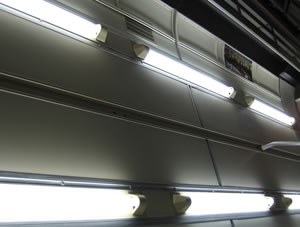- 1 read

Approximately a quarter of the total electricity generated in the U.S. is used for lighting, according to the U.S. Department of Energy. Lighting in homes represents as much as 25 percent of a home’s electricity use while more than half of the energy is consumed in the commercial sector, due to the fact that lighting is used most during periods of peak electrical demand and also contributes to a building's internal heat generation, which then ups air-conditioning load, DOE says.
The U.S. spends approximately $58 billion annually to light homes, offices, streets and factories. The significance of that figure lies in the fact that the conversion of electricity into useful light is one of the least efficient energy conversion processes in buildings today. DOE and efficiency advocates promote newer lighting technologies to improve the energy efficiency of lighting and reduce building energy consumption and costs.
Most existing buildings are outfitted with older building materials and technology, particularly fluorescent lights, which add to a building’s inefficiency and operating costs. Additionally, fluorescent lights:
- are breakable, unlike light emitting diode (LED) tube lights.
- contain mercury, which if released emits vapors that are toxic to humans, particularly children and pregnant women, if exposure is significant.
- flicker as they die out.
- if unfiltered, due to the ultraviolet radiation emitted, have been alleged to acerbate or trigger problems in individuals with lupus or suffering from headaches or migraine headaches.
- have a ”warm up” time.
- are expensive to recycle.
- give off heat.
- do not work well in severe cold.
Conversely, commercial application of LED lighting provides many advantages. LED lighting is a solid-state lighting technology, of which DOE says, “No other lighting technology offers as much potential to save energy and enhance the quality of our building environments, contributing to our nation's energy and climate change solutions.”
Here are some unique LED characteristics courtesy of DOE:
- directional light emission.
- can be very compact and low-profile.
- resistant to breaking – no breakable glass or filaments.
- cold temperature operation – performance improves in the cold.
- require no "warm up" time.
- compatible with electronic controls to change light levels and color characteristics.
- no infrared or ultraviolet radiation emitted.
- last longer than conventional bulbs.
Also, lighting upgrades pay for themselves in the energy and maintenance saved. Upgrading to LED lighting yields approximately 60 to 90 percent savings on lighting costs and such energy-efficiency improvements increase net operating income and asset value. In fact, ENERGY STAR calculates that a 10 percent decrease in energy use could lead to a 1.5 percent increase in net operating income, with even more impressive figures as energy savings grow.
Businesses and universities of various sizes have reduced annual operating costs by installing energy efficient lighting in their buildings. One private company, LED Saving Solutions is in the business of making energy efficiency possible and has forged production and financial partnerships that allow it to take on the initial cost of replacing conventional lighting, making the retrofit cash-flow positive for properties from the start.

